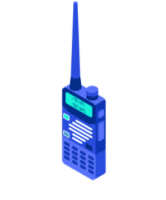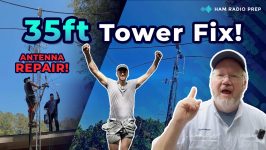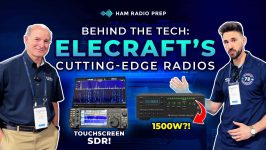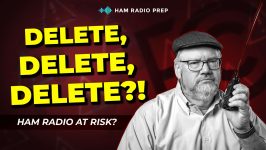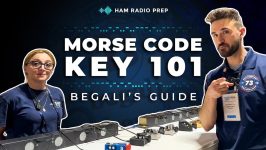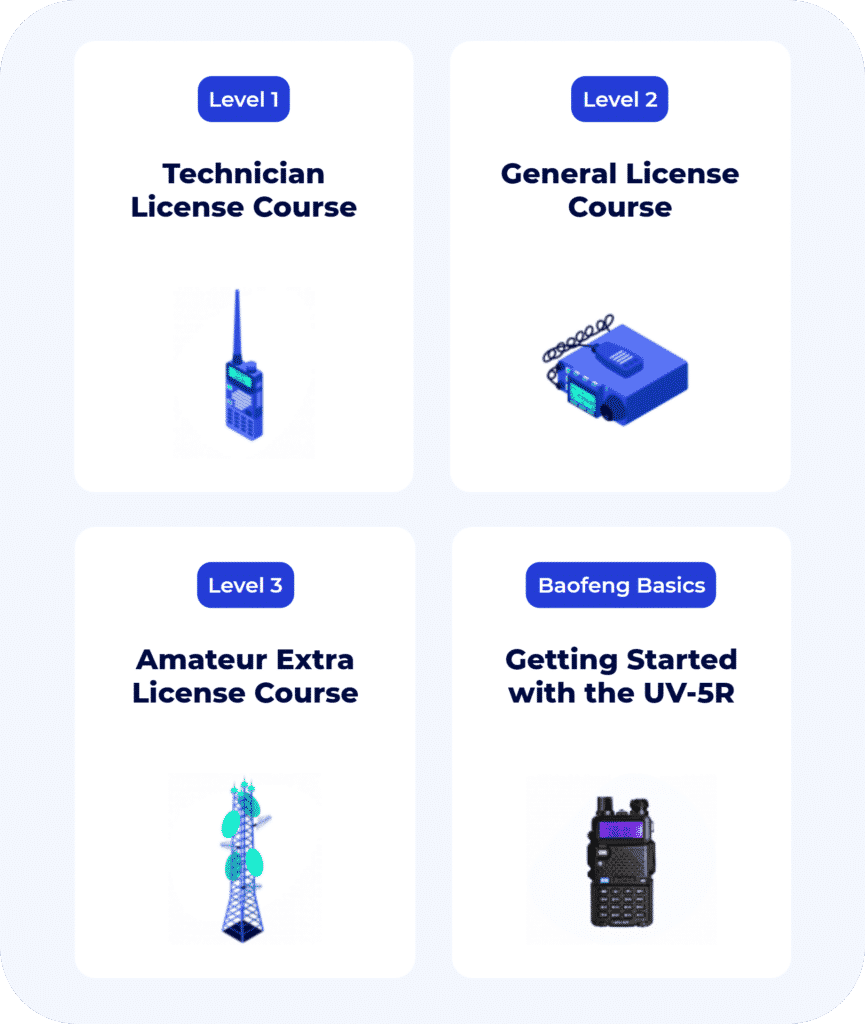Every ham radio operator needs a good handheld radio. Whether you’re just starting out or looking to upgrade your toolkit, finding the right handheld radio can be overwhelming with so many options on the market. To help, the Ham Radio Prep team reviewed all the major models available in 2025 to bring you our picks for the top 5 handheld ham radios this year.
We considered price, functionality, modes of operation, ease of use, and overall value when ranking these radios. Let’s dive in!
Top 5 Handheld Ham Radios in 2025
5. Baofeng BF-F8HP Pro Inexpensive

Estimated Price: ≈ $70
The Baofeng BF-F8HP Pro is an excellent entry-level radio with an unbeatable price point. Built on Baofeng’s popular platform, it features an upgraded 8-watt output and a full-color screen for added functionality. This radio transmits on the 2-meter and 70-centimeter bands and also doubles as a versatile receiver, picking up FM broadcast, weather services, aviation bands, and GMRS frequencies.
It’s an excellent option for beginners due to its affordability and ease of use. Even experienced hams often keep a Baofeng handy as a backup or for casual use. With this radio you can expect to work simplex contacts in the 5 mile range and hit local repeaters in town to give your signal even longer reach.
Because of their price points, the Baofengs are very popular ham radios, and it’s hard to go wrong here. Even experienced hams often have one lying around, in their truck, or a part of a go kit.
If you need to learn how to use your Baofeng, check out the Ham Radio Basics course.
Reasons to get the BF-F8HP Pro:
- Affordable and beginner-friendly
- Dual-band operation
- USB-C charging
- 8-watt output for better range
- Excellent value for the price
Honorable Mention: Quansheng UV-K5 For under $30, the Quansheng UV-K5 offers exceptional value for those who enjoy experimenting with their gear. While it lacks some of the refined features of higher-end models, it’s a great option for those looking to explore the hobby on a budget.
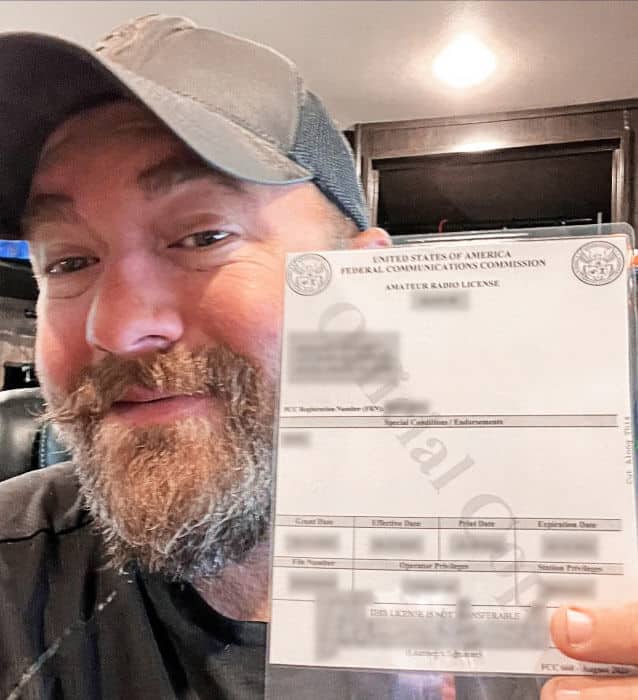
Take a free 5-minute lesson to take the first step to getting licensed.

4. Yaesu FT5DR Reliable
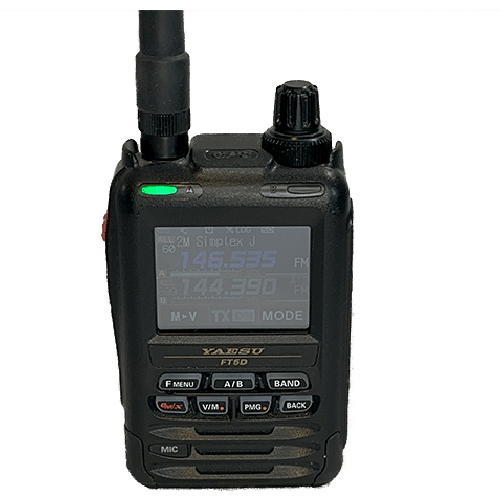
Estimated Price: ≈ $400
Yaesu’s FT5DR is a feature-packed handheld perfect for hams looking to explore digital modes and APRS functionality. Its rugged design includes waterproofing and a large color touchscreen, making it durable and user-friendly.
Supporting the System Fusion (C4FM) digital mode, the FT5DR is easy to set up and operate, even for those new to digital. The addition of Bluetooth, APRS, and a MicroSD slot for programming and recording makes this radio a top choice for advanced users.
Reasons to get the FT5DR:
- System Fusion support
- Touchscreen interface
- Rugged and waterproof (IPX7 rating)
- APRS functionality
- Bluetooth capability
Honorable Mention: Yaesu FT-70DR
For those seeking a more budget-friendly option, the FT-70DR offers System Fusion support and rugged reliability for under $200.
3. Yaesu FT-65RRugged
Estimated Price: ≈ $110

The Yaesu FT-65R stands out for its rugged design and reliability, making it a favorite for emergency communications. Its straightforward programming and strong manufacturer support make it a great choice for those prioritizing durability over advanced features.
With a cost-effective price point and excellent accessory options, the FT-65R is ideal for building a go-kit or for use in field operations. Its dependable performance and ease of use make it a must-have for emergency preparedness.
Reasons to get the FT-65R:
- Rugged and durable design
- Reliable performance
- Straightforward programming
- Affordable price point
Honorable Mentions:
Yaesu FT-4XR: A smaller alternative with similar features for about $10 more.
ICOM IC-T10: Slightly pricier at $150 but offers similar reliability and build quality.
2. Anytone AT-D878UVII PlusGo Digital - DMR
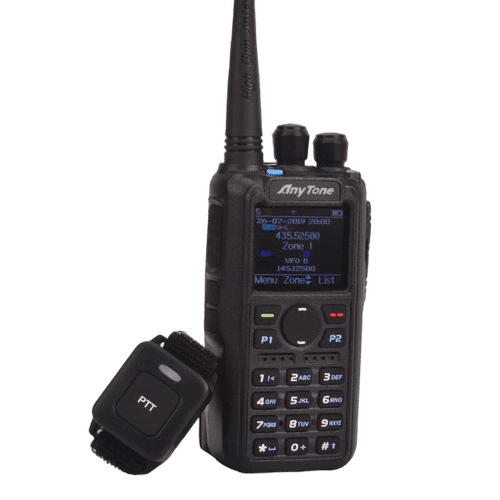
Estimated Price: ≈ $350 (with accessories)
The Anytone AT-D878UVII Plus is a versatile handheld that excels in FM, DMR, and APRS functionality. Its large color screen and built-in GPS make it a standout for those looking for advanced features in a single device. Despite its brick-like form factor, it delivers exceptional value for its price.
DMR programming can be challenging, but with the right resources, it’s manageable. The robust feature set and accessory bundles make this radio a top pick for those willing to invest time in mastering digital modes.
Reasons to get the AT-D878UVII Plus:
- DMR
- Color screen
- Large on-board memory capacity (500,000 DMR Contacts)
- Great Bluetooth support
- GPS & APRS support
- Comprehensive accessory bundles available
Radioddity GD-88: A capable alternative with a larger screen and similar features for under $290.
Radioddity GD-73: A minimalist option for home hotspot users, priced around $80.
1. Kenwood TH-D75ATop of the Line

Estimated Price: ≈ $750
The Kenwood TH-D75A is the ultimate handheld radio for those seeking premium functionality and versatility. With native support for FM, D-STAR, and APRS, as well as onboard GPS, this radio offers unparalleled performance.
Upgraded with USB-C charging and connectivity, the TH-D75A is designed for convenience and modern compatibility. Its high price reflects its top-tier features, making it the ideal choice for serious operators who demand the best.
Reasons to get the TH-D75A:
- Comprehensive feature set (FM, D-STAR, APRS)
- USB-C charging and connectivity
- Onboard GPS
- Exceptional build quality
- Ideal for advanced users
Honorable Mentions:
ICOM ID-52A Plus: Offers D-STAR with Bluetooth and a color screen for under $700.
ICOM ID-50A: A budget-friendly entry-level D-STAR option priced around $400.
Which Digital Should I Choose?
Ultimately, the choice in Digital boils down to availability.
According to a November 2022 check of RepeaterBook.com in North America there are more than 2,100 DMR repeaters, about 1,200 D-STAR options and around 2,300 Fusion repeaters.
That said, we recommend checking 2 things before going all in on a digital format. First, what’s in your neighborhood. The easiest digital format to get started on is what’s on the repeater up the street, you can usually find a local club to help with questions when you get started. So check repeaters in your area and find out if DMR, D-Star, or Fusion is more popular if you want to go digital.
Second, if you plan to work with a group, know their preferred digital format. For instance, Georgia ARES is focused on a statewide D-STAR network, and that is not cross compatible with Fusion or DMR. The point here is there is no standard for what different formats local clubs and groups like ARES around the country use. Talk with them locally before you invest a lot of money into a radio if your plan is to join up and support them.
Conclusion
Whichever handheld radio you choose, it’s important to match your choice with your needs and operating style. Whether you’re a beginner seeking an affordable entry point or an experienced ham looking for advanced digital features, there’s a perfect option for you on this list.
-
For beginners: Baofeng BF-F8HP Pro
-
For rugged reliability: Yaesu FT-65R
-
For digital experimentation: Anytone AT-D878UVII Plus
-
For advanced features: Kenwood TH-D75A
If you’re just starting your ham radio journey, check out our Ham Radio Basics Course at HamRadioPrep.com to get started.
If you like the idea of having a handheld ham radio, but haven’t gotten your license yet you can get started with our 10 lesson Technician course that has videos, quizzes and games to teach you everything you need to pass the FCC exam on the first try.






